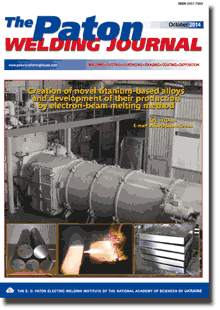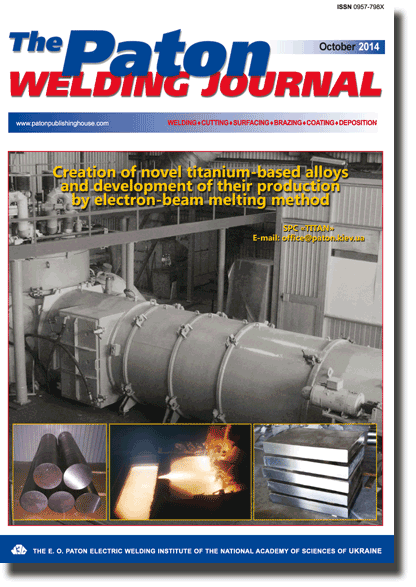| 2014 №10 (07) |
DOI of Article 10.15407/tpwj2014.10.08 |
2014 №10 (09) |

The Paton Welding Journal, 2014, #10, 38-44 pages
BRAZE-WELDED TUBULAR BILLETS FOR PIPELINES AND HIGH-PRESSURE VESSELS
A.A. PISMENNY, R.S. GUBATYUK, A.S. PROKOFIEV, A.F. MUZHICHENKO and A.S. SHINKARENKO
E.O. Paton Electric Welding Institute, NASU. 11 Bozhenko Str., 03680, Kiev, Ukraine. E-mail: office@paton.kiev.uaAbstract
Application of two-layer shells for formation of common wall is supposed to be prospective for reduction of weight of pipeline structures as well as pressure vessels. Calculation of three single-type pressure vessel structures, having common wall, which is made as two-layer shell, was carried out. At that, analysis was given for applied materials and their combination used for manufacture of internal and external shells of common two-layer wall of three types of pressure vessels considering their strength indices. It is determined that application of the same steel grade in two-layer structure does not result in efficient loading of common wall. Application of material with higher strength characteristics for manufacture of external shell results in efficient loading of their common wall, reduction of its thickness and growth of its internal stresses, i.e. reasonable loading. Considered are the issues of application of mesh-like material for manufacture of external shell as well as usage of high-frequency pressure braze-welding in production of perspective tubular billets, designed for pipelines and high-pressure vessels. Ref. 12, Tables 7, Figures 8.
Keywords: pressure braze-welding, tubular billet, thin-wall shell, stresses, simulation model
Received: 11.06.14
Published: 28.10.14
References
1. Pismenny, A.S., Prokofiev, A.S., Gubatyuk, R.S. et al. (2012) Increase of strength characteristics of spirally-welded pipes of structural designation. The Paton Welding J., 3, 30-34.
2. Pisarenko, G.S., Yakovlev, A.P., Matveev, V.V. (1988) Handbook on strength of materials. Ed. by G.S. Pisarenko. 2nd ed. Kiev: Naukova Dumka.
3. Majzel, V.S., Navrotsky, D.I. (1973) Welded structures. Leningrad: Mashinostroenie.
4. Forum, A.M. (2009) Our balloons will withstand any storm! AGZK+AT, 2, 31-33.
5. Sakhatov, R.M. (2009) Nonshatterable metal-composite cylinders BMK-300V and others. Ibid., 4, 51-55.
6. Chernega, V.I. (1976) Safety servicing of steam boilers, vessels and pipelines (Transact. of official documents). 2nd ed. Kiev: Tekhnika.
7. Tabelev, V.D. (1991) Peculiarities of joint formation in brazing with plastic deformation of base metal. Avtomatich. Svarka, 7, 5-9.
8. Tabelev, V.D., Kareta, N.L., Panasenko, A.I. et al. (1985) Structure and phase composition of welds made by capillary and pressure brazing. Ibid., 11, 26-29.
9. Lebedev, V.K., Tabelev, V.D., Pismenny, A.S. (1983) Butt pressure brazing. Ibid., 9, 25-27.
10. DSTU 3761.2-98: Welding and related processes.
11. Bakshi, O.I., Shrou, R.Z. (1962) Strength under static tension of welded joints with soft interlayer. Svarochn. Proizvodstvo, 5, 6-10.
12. Lebedev, V.K., Pismenny, A.S., Kasatkin, O.G. et al. (1990) Physical modeling of upsetting in butt welding and braze-welding of pipes. Avtomatich. Svarka, 8, 17-20.
Suggested Citation
A.A. Pismenny, R.S. Gubatyuk, A.S. Prokofiev, A.F. Muzhichenko And A.S. Shinkarenko (2014) BRAZE-WELDED TUBULAR BILLETS FOR PIPELINES AND HIGH-PRESSURE VESSELS. The Paton Welding J., 10, 38-44.The cost of subscription/purchase order journals or individual articles
| Journal/Currency | Annual Set | 1 issue printed |
1 issue |
one article |
| TPWJ/USD | 384 $ | 32 $ | 26 $ | 13 $ |
| TPWJ/EUR | 348 € | 29 € | 24 € | 12 € |
| TPWJ/UAH | 7200 UAH | 600 UAH | 600 UAH | 280 UAH |
| AS/UAH | 1800 UAH | 300 UAH | 300 UAH | 150 UAH |
| AS/USD | 192 $ | 32 $ | 26 $ | 13 $ |
| AS/EUR | 180 € | 30 € | 25 € | 12 € |
| SEM/UAH | 1200 UAH | 300 UAH | 300 UAH | 150 UAH |
| SEM/USD | 128 $ | 32 $ | 26 $ | 13 $ |
| SEM/EUR | 120 € | 30 € | 25 € | 12 € |
| TDNK/UAH | 1200 UAH | 300 UAH | 300 UAH | 150 UAH |
| TDNK/USD | 128 $ | 32 $ | 26 $ | 13 $ |
| TDNK/EUR | 120 € | 30 € | 25 € | 15 € |
AS = «Automatic Welding» - 6 issues per year;
TPWJ = «PATON WELDING JOURNAL» - 12 issues per year;
SEM = «Electrometallurgy Today» - 4 issues per year;
TDNK = «Technical Diagnostics and Non-Destructive Testing» - 4 issues per year.


